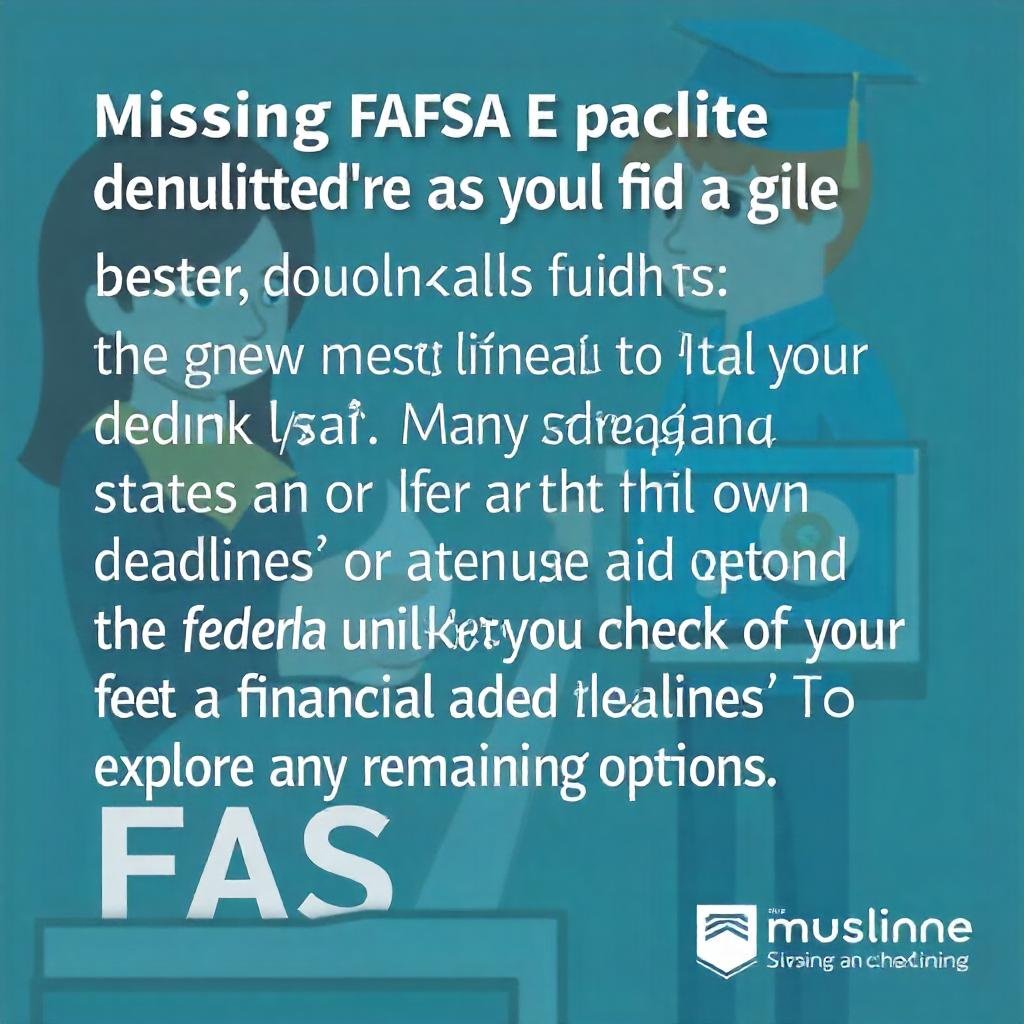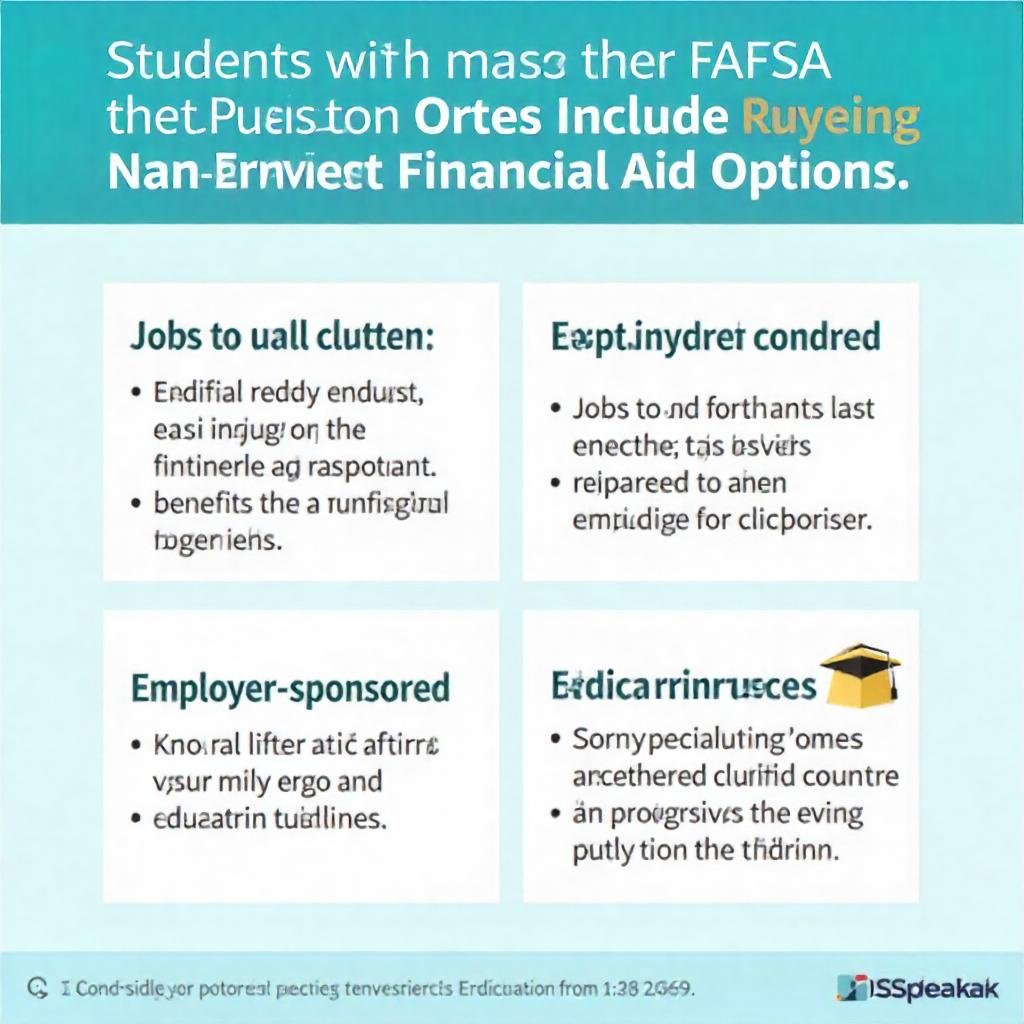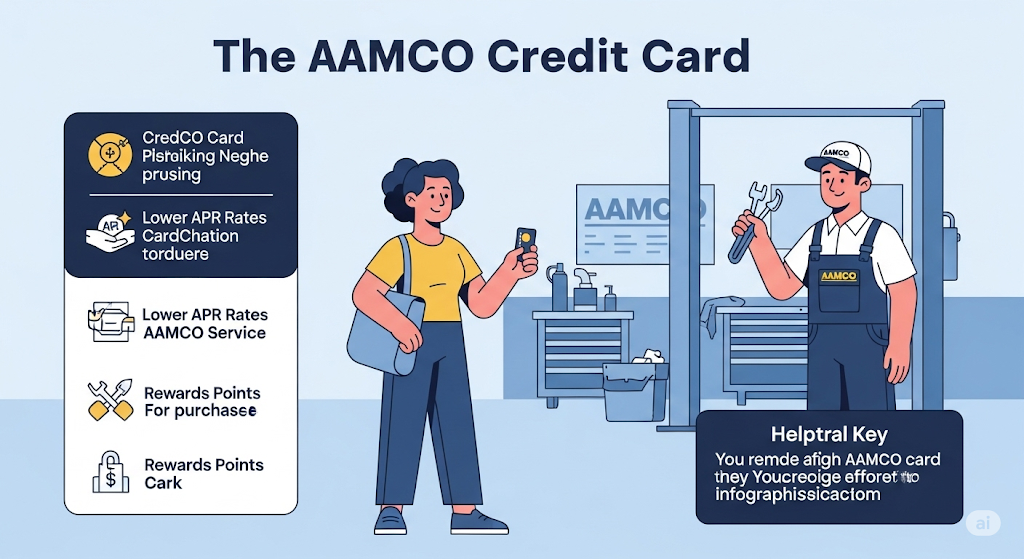
Missing the FAFSA deadline can feel like a major setback, but it does not always mean the end of financial aid opportunities. Many schools and states have their own deadlines or offer alternative aid options beyond the federal deadline. If someone missed the FAFSA deadline, they should check with their school’s financial aid office immediately to explore any remaining options.
Some colleges accept late FAFSA submissions under specific circumstances or offer institutional grants that don’t require FAFSA. Additionally, students can still apply for scholarships and private aid that may not depend on FAFSA eligibility. Understanding these alternatives can help maintain access to funding despite the missed deadline.
Understanding FAFSA Deadlines
FAFSA deadlines vary by federal, state, and college requirements, which influences eligibility for different types of aid. Missing deadlines can limit or eliminate access to certain financial aid options. Staying current with these dates is crucial for maximizing aid opportunities.
Types of FAFSA Deadlines
There are three main types of FAFSA deadlines: federal, state, and college-specific. The federal deadline is typically June 30 of the academic year for which aid is requested. States often set earlier deadlines that can impact eligibility for state grants or scholarships.
Colleges may also impose their own deadlines to determine institutional aid eligibility. These can be as early as January or February before the academic year starts. Meeting all three deadlines is necessary to access the full range of financial aid.
Consequences of Missing the Deadline
Missing the federal deadline generally means no federal aid, such as Pell Grants or federal student loans, for that academic year. State and institutional aid often operates on a first-come, first-served basis, so late filings may result in reduced or no access to those funds.
Students may have to rely on private loans or alternative financing if deadlines are missed. Some schools may offer limited exceptions, but these are rare and typically require special circumstances.
Key Dates and How to Stay Informed
The FAFSA application opens annually on October 1 for the following school year. Key dates include the federal deadline (June 30), state deadlines, and individual school deadlines, which vary widely.
Students should create a deadline calendar listing all important dates. Reliable sources include the official FAFSA website, state education agency pages, and the financial aid office of their college or university. Subscribing to alerts and checking updates regularly helps prevent missing important deadlines.
Immediate Steps If You Missed the FAFSA Deadline
Missing the FAFSA deadline does not always mean all financial aid opportunities are lost. You should act quickly by contacting your school’s financial aid office, verifying other relevant deadlines, and checking if late filing options are available.
Contact Your School’s Financial Aid Office
The first action is to reach out directly to the financial aid office of the intended college. They can provide specific guidance on whether you can still submit the FAFSA and what alternative aid programs might be available.
Many schools offer institutional grants or scholarships that do not require FAFSA or have separate deadlines. A financial aid advisor may also help clarify how net income—your adjusted gross income minus deductible expenses—impacts eligibility for aid.
Schools sometimes approve late FAFSA submissions due to special circumstances. Providing documentation, such as proof of income or household changes, might increase the chances of aid consideration despite the missed deadline.
Check for State and Institutional Deadlines
State financial aid programs often have different deadlines than the federal FAFSA. Students should verify these dates through their state’s education department website or relevant college pages. Missing the federal FAFSA deadline does not always affect state aid eligibility if state deadlines are later.
Some institutions run their own aid applications altogether. They may require school-specific forms or have deadlines independent from FAFSA. Understanding these timelines is crucial to avoid missing other financial aid opportunities.
Checking for deadlines includes confirming whether the institution or state requires direct deposit information like a routing number for aid disbursement. Having this ready can speed up the process once aid is approved.
Explore Late Filing Options
Certain circumstances allow students to submit the FAFSA late. These include changes in financial status, family emergencies, or administrative errors. Schools may use a process called “verification” to assess late applications carefully.
If late filing is possible, students should complete the FAFSA as soon as possible. Missing deadlines decreases the total aid available, but partial aid or loan options may remain accessible.
It is important to provide accurate financial data, including income details and banking information such as the routing number, to avoid processing delays. Prompt action enhances chances for receiving aid even after the deadline has passed.
Alternative Financial Aid Options

Missing the FAFSA deadline does not end the search for financial aid. Students can explore private scholarships, state grants, and institutional aid to help fund their education. These options vary in eligibility, application processes, and deadlines but often provide substantial support.
Pursue Private Scholarships
Private scholarships come from organizations, companies, and foundations outside of the federal system. Many are merit-based, need-based, or focused on specific fields, backgrounds, or interests.
Students should use scholarship databases like Fastweb or Scholarships.com to find targeted awards. Deadlines often differ from FAFSA’s, so some may still be open after the federal deadline. Applying to multiple scholarships increases chances of funding.
Some scholarships require essays, recommendation letters, or portfolios. Keeping materials organized and applying early will improve success. Additionally, combining scholarships with personal loans, including the best personal loans with a cosigner in 2025, can help cover remaining costs.
Apply for State-Specific Grants
Each state administers grants with eligibility rules and deadlines separate from federal aid. These grants often target residents, specific majors, or income levels. States like California and Texas offer extensive aid that might still be accessible after the FAFSA deadline.
Students can visit their state’s higher education agency website to find current grant opportunities. Deadlines vary widely; some may have later or rolling deadlines. Applying quickly helps meet these timelines.
State grants rarely meet full tuition, so combining them with other options like best credit cards of May 2025 or simple ways to make $100 fast might provide extra funds. Understanding credit terms is essential to avoid financial strain.
Seek Institutional Aid
Colleges often have their own emergency funds or alternative financial aid programs independent of FAFSA. This aid can include grants, scholarships, or work-study opportunities available even after federal deadlines pass.
Students should contact their school’s financial aid office directly to inquire about deadlines and eligibility. Each institution’s policy differs, but many reserve some funds for late applicants or for students in special circumstances.
Institutional aid may require supplemental applications or documentation. Combining this aid with debt consolidation strategies or small investments such as best index funds for 2025 can make the financial burden more manageable over time.
Federal Student Loan and Grant Options Beyond FAFSA
Missing the FAFSA deadline does not always end access to federal financial aid. Some loan programs allow applicants to secure funds independently, while grant eligibility can sometimes remain even if the application is late. Understanding these options can help students maintain financial support for their education.
Direct Unsubsidized Loans
Direct Unsubsidized Loans are available to undergraduate and graduate students regardless of financial need. These loans accrue interest from the time they are disbursed, and borrowers are responsible for paying that interest.
The application process often requires completing the FAFSA, but schools can sometimes offer these loans if alternative documentation is provided. Borrowers do not need a minimum credit score to qualify, making these loans more accessible than private loans or those requiring strong credit histories, which often demand scores above 660 for favorable terms.
Interest rates are fixed by the federal government and tend to be lower than private loan rates, usually around 5% to 7% for undergraduates and slightly higher for graduates. Students should compare these loans against private options, keeping credit and income in mind.
PLUS Loans for Parents and Graduates
Federal PLUS Loans are available to parents of dependent undergraduates and to graduate students. These loans require a credit check but not a minimum credit score, though borrowers with adverse credit history may face denial or need an endorser.
PLUS Loans can cover education costs not met by other financial aid, including tuition, fees, and living expenses. Interest rates currently average about 8% and interest starts accruing immediately, similar to unsubsidized loans.
Since they often require better credit standing than Direct Unsubsidized Loans, these loans may be harder to get for those with credit issues. However, they can be a valuable option when FAFSA deadlines are missed and alternative aid is limited.
Pell Grant Eligibility After Missing the Deadline
Pell Grants are federal grants that do not require repayment and are usually based on demonstrated financial need through FAFSA submission. Missing the FAFSA deadline typically prevents eligibility, but some students may qualify if their school has remaining grant funds and accepts late applications.
Schools sometimes have limited discretionary funds that could be applied to late applicants, but this varies widely. Students should contact their financial aid office immediately to explore special circumstances or appeal processes.
Unlike loans, Pell Grants do not require credit checks or repayment, so eligibility rules are strictly tied to timely FAFSA completion unless exceptions apply. This makes early FAFSA submission critical for accessing these grants.
Utilizing Non-FAFSA Funding Sources

Students who miss the FAFSA deadline can explore other financial aid options. These include jobs that offer education benefits, employer-sponsored tuition programs, and military-related education funding.
Work-Study Opportunities
Work-study programs provide part-time jobs for students with financial need. They typically take place on campus and pay at least the federal minimum wage. Although connected to FAFSA, some schools offer work-study-like jobs even if a student misses FAFSA.
Jobs can range from library assistant roles to research jobs. Income can help cover daily expenses and minimize student loans. Students should check with their school’s financial aid or career office about available positions.
Employer Tuition Assistance
Many companies offer tuition assistance to employees. This typically covers part or all of the cost of classes, often with a cap per year. Employees must usually stay with the company for a certain period after receiving benefits.
Employers may require proof of course completion and maintain a minimum grade. This option is valuable for those working full or part-time during school. It can also extend to family members in some cases.
Military and Veterans Education Benefits
Active-duty military members, veterans, and dependents have access to education benefits like the GI Bill. These benefits cover tuition, housing, and supplies. Programs and eligibility vary based on service length and discharge status.
Military education benefits do not depend on FAFSA. The Department of Veterans Affairs administers these programs. Beneficiaries should verify eligibility and apply through the VA website for financial support.
Planning Your Finances After Missing the FAFSA
Managing education expenses without FAFSA aid requires a clear financial plan. This means adjusting budgets to cover tuition and living costs, exploring alternative loan options, and establishing credit responsibly for future borrowing needs.
Budgeting for Education Costs
After missing the FAFSA deadline, students should create a detailed budget focusing on fixed and variable education expenses. Tuition, fees, books, and supplies make up fixed costs, while food, transportation, and personal expenses vary monthly.
A sample budget could look like this:
| Expense | Estimated Monthly Cost |
| Tuition/Fees | $1,000 |
| Books/Supplies | $200 |
| Housing | $600 |
| Food | $300 |
| Transportation | $150 |
| Personal Expenses | $150 |
Cutting discretionary spending, such as dining out or subscriptions, can free funds for essentials. Tracking spending weekly helps keep expenses aligned with the budget.
Considering Private Student Loans
Without FAFSA assistance, private student loans can fill the funding gap but often carry higher interest rates and fewer protections. Interest rates vary widely, commonly ranging from 7% to 14%, depending on creditworthiness and lender policies.
Borrowers should compare terms carefully, including origination fees, repayment options, and whether interest accrues during school. Loans with co-signers might receive better rates but carry risks for both parties.
Federal loan options like Direct PLUS loans remain available even if FAFSA was missed, but they require an application through FAFSA or separate processes. Private loans should only be a last resort after exhausting scholarships, grants, and savings.
Building Credit as a Student
Building credit can help students qualify for better loan terms later. Starting with a student credit card or becoming an authorized user on a family member’s card are common ways to establish credit history.
Students should keep utilization below 30% of their credit limit and pay balances in full monthly to avoid high-interest charges. The average credit card interest rate in America today is about 20%, so carrying balances is costly.
Maintaining on-time payments and low balances boosts credit scores. This also positively affects future credit applications, including auto loans, where the average car payment in 2025 is approximately $575 per month with an average loan term of 69 months. Good credit can reduce interest rates significantly on such loans.
Impact on Tuition Payment and Enrollment
Missing the FAFSA deadline can affect how and when a student is required to pay tuition. It may also influence their ability to register for classes and secure campus housing.
Delayed or Partial Payment Options
Students who miss the FAFSA deadline often lose immediate access to federal financial aid, creating a gap in their tuition funding. Many colleges offer payment plans that allow students to pay tuition in installments without interest. These plans can reduce financial strain while awaiting aid approval.
Some schools permit partial payments to hold a student’s spot in classes. However, without federal aid applied, the total out-of-pocket cost must be covered upfront or through loans. Students should contact their school’s financial office quickly to explore available payment plans tailored to their situation.
Consequences for Registration and Housing
Failing to submit FAFSA on time may block a student from registering for classes, especially in institutions with strict deadlines tied to financial aid verification. Some colleges place holds on registration accounts until proof of sufficient funding is provided.
Housing assignments can also be impacted. Certain campuses require confirmed financial aid or tuition payments as part of the housing contract process. Students might lose priority housing options or face delays in receiving assignments if aid is not established before deadlines. Contacting registration and housing offices early is essential to understand individual school policies.
Special Circumstances and Appeals
Missing the FAFSA deadline does not always mean the end of financial aid possibilities. Some students can request a review or appeal, especially when unusual or unexpected financial situations have affected their ability to file on time.
How to File for a FAFSA Appeal
Students or families must contact the financial aid office of their college directly to start an appeal. The appeal process varies by institution but usually requires a formal written request explaining why the FAFSA was late.
Colleges look for reasons like illness, natural disaster, or other emergencies that prevented timely filing. The appeal should include specific deadlines missed and a clear request for reinstatement of financial aid consideration.
It is also vital to meet any new deadlines set by the school. Federal and state financial aid offices generally do not grant appeals, making the college office the best place to focus efforts.
Documenting and Explaining Extenuating Circumstances
Strong documentation is critical for a successful appeal. This means providing medical records, letters from employers, or official government notices to verify the reason for missing the FAFSA deadline.
Applicants should detail how their income or tax situation changed unexpectedly. For example, a family moving into a different tax bracket or facing reduced income often strengthens the case for reconsideration.
Clear, concise statements coupled with relevant evidence improve the chances that schools will allow a late FAFSA submission or adjust aid eligibility based on changed financial conditions.
Preparing for Future FAFSA Cycles

Planning ahead can prevent missing deadlines and reduce stress during the FAFSA application process. Staying organized with key dates and required documents helps ensure a smooth application each year.
Setting Reminders for Upcoming Deadlines
He should note that FAFSA opens on October 1 each year, with state and school deadlines varying widely. Creating calendar alerts on phones or computers well before deadlines can avoid last-minute issues.
Using apps like Google Calendar or reminder tools on smartphones works best. It’s smart to set multiple alerts: one for the FAFSA opening date and others for the specific deadlines of his state and college.
Checking the official FAFSA website for updated deadlines is critical. Many states have different cutoff dates for their aid programs, which can be found at studentaid.gov.
Gathering the Right Documentation
Having all necessary documents ready simplifies future FAFSA submissions. Important documents include his Social Security Number, tax returns, and bank statements.
He should also prepare his employer’s Identification Number (EIN), which is sometimes needed if he must verify income sources. To find an EIN, he can search the IRS website or contact the employer directly.
Additionally, knowing his bank routing number and account number is helpful when entering financial details. He can find the routing number on checks or through his bank’s online portal.
Organizing these documents in a dedicated folder—physical or digital—makes access easier as the application period approaches.
Common Mistakes and How to Avoid Them
Missing key details or failing to follow specific guidelines frequently causes issues with FAFSA submissions. Proper preparation and double-checking essential requirements helps applicants avoid costly errors.
Incomplete Application Information
Many applicants submit FAFSA forms without fully completing all required fields, which can delay processing or lead to rejection. Common omissions include missing Social Security numbers, income information, or signatures.
Applicants should use the IRS Data Retrieval Tool when available to automatically fill income data, reducing errors. It is important to carefully review each section before submitting and save a copy for reference.
Failure to include all dependent information, including step-parents where applicable, can impact eligibility. Document checklists can help ensure every item is accounted for. Missing attachments or incorrect details may require time-consuming corrections later.
Not Reviewing State and Institutional Requirements
FAFSA deadlines and additional forms can vary by state and college. Some states require separate applications or have earlier deadlines than the federal FAFSA. Ignoring these can result in lost aid opportunities.
Applicants should visit their state’s education funding website to verify specific deadlines. Institutions may also ask for extra documents like tax returns or verification forms.
Failing to check these details often leads to incomplete aid packages. Setting calendar reminders for both FAFSA submission and related state or school dates helps maintain compliance.
Understanding these requirements is essential, especially since some states adjust aid based on their budgets. Staying informed ensures no available funding is missed.
Long-Term Financial Planning for College Students
Effective college financial planning involves managing unexpected expenses and making smart investment choices to grow wealth over time. Prioritizing an emergency fund and selecting appropriate investment vehicles can support financial stability and future goals.
Building an Emergency Fund
An emergency fund protects students from unforeseen costs like medical bills or car repairs. It is advisable to save between three to six months’ worth of essential living expenses. This fund should be kept in a high-yield savings account for easy access and modest interest earnings.
Students should contribute regularly, even small amounts, to build this fund steadily. Avoid using credit cards or loans for emergencies, as they increase debt. The fund also provides peace of mind, reducing stress related to financial uncertainties during college years.
Evaluating Long-Term Investment Strategies
For wealth growth, students can consider low-cost index funds, which track the market and have returned an average of 7-10% annually over decades. Some of the best index funds for 2025 include Vanguard Total Stock Market ETF (VTI) and Fidelity ZERO Total Market Index Fund (FZROX).
Diversification across assets reduces risk. For example, mixing index funds with bonds and blue-chip stocks balances growth and safety. Alternative investments like Bitcoin showed high past returns—$1,000 invested 10 years ago would now be tens of thousands—but also carry high volatility and risk.
Students should invest with a long-term horizon and avoid frequent trading. Using tax-advantaged accounts such as Roth IRAs maximizes compounding benefits and improves overall returns.




